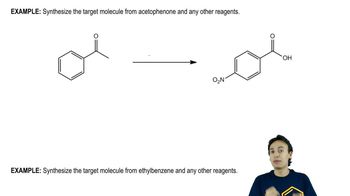Here are the essential concepts you must grasp in order to answer the question correctly.
Benzene and its Derivatives
Benzene is a fundamental aromatic hydrocarbon characterized by its stable ring structure and delocalized π-electrons. Understanding benzene's reactivity is crucial, as it undergoes electrophilic substitution reactions rather than addition, allowing for the introduction of various functional groups while preserving its aromaticity.
Recommended video:
Aromatic synthesis starting with benzene/benzene derivatives
Diazonium Ions
Diazonium ions are highly reactive intermediates formed from primary aromatic amines and nitrous acid. They play a pivotal role in organic synthesis, particularly in the formation of azo compounds and in electrophilic aromatic substitution reactions, where they can introduce substituents onto aromatic rings.
Recommended video:
Metal Ion Catalysis Concept 1
Electrophilic Aromatic Substitution
Electrophilic aromatic substitution (EAS) is a key reaction mechanism in organic chemistry where an electrophile replaces a hydrogen atom on an aromatic ring. This process is essential for synthesizing substituted aromatic compounds, such as 4-methoxyaniline, by utilizing diazonium ions to introduce new functional groups onto the benzene ring.
Recommended video:
 Verified step by step guidance
Verified step by step guidance Verified video answer for a similar problem:
Verified video answer for a similar problem:



 9:12m
9:12m